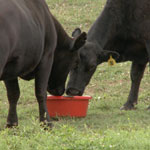 Feeding a cattle fly control mineral in the fall can curb spring fly populations. Shrinking horn fly population in the fall might not seem like a nuisance to your cattle. However, horn flies can hibernate and survive the winter, developing into a prolific fly population come spring.
Feeding a cattle fly control mineral in the fall can curb spring fly populations. Shrinking horn fly population in the fall might not seem like a nuisance to your cattle. However, horn flies can hibernate and survive the winter, developing into a prolific fly population come spring.
What precautions can you take now to get a head start on spring fly populations?
Here are answers to top fall fly control questions:
Q: How can you proactively curb spring fly populations in the fall?
A: Feed Purina® Wind and Rain® Fly Control Mineral with Altosid® Insect Growth Regulator (IGR) through summer, until 30 days after the first frost in the fall.1 Keeping fly control mineral out long enough in the fall is just as important to control flies as providing it early enough in the spring (30 days before the last frost).
Q: Why keep feeding cattle fly control mineral if fly populations are declining?
A: Keeping fly control mineral out 30 days after the first frost in fall gives you a head start on controlling next year’s fly populations.
Horn flies overwinter (hibernate) in the pupal stage, which can jump-start adult populations in the spring. Using fly control mineral longer in the fall decreases the opportunity for flies to overwinter below manure patties because Altosid® IGR stops horn fly development. That means those eggs can’t develop into adult flies come spring.
If you don’t keep fly control mineral out for 30 days after the first frost, you also risk temperatures bouncing back and allowing more fly generations to survive.
Q: How do I transition cattle off fly control mineral?
A: Switching between mineral formulas is simple – just fill the feeder or set out a tub of the new mineral once the fly control mineral is gone. All Wind and Rain® minerals feature a special formulation to help cattle consume mineral at target intake levels. At the same time, the weatherized mineral’s large particle size holds up to mother nature for a smooth transition, anytime.
Q: Will it negatively impact cattle if I feed fly control mineral for too long?
A: Wind and Rain® Fly Control Mineral functions via Altosid® IGR passing into the manure to stop horn fly development. Cattle do not absorb IGR into their bloodstream, so they’re not negatively impacted by continual consumption. However, depending on your location, it might not make economic sense to feed fly control mineral after cattle no longer need it.
Alternately, if you live in a southern state, consider offering fly control mineral year-round since fly season lasts so long. Using the same mineral all year can also simplify your mineral program.
Q: How can I make the most of fly control mineral through fall?
A: Ensure cattle are consuming mineral at target levels. If cattle aren’t consuming enough fly control mineral, they won’t get the full fly control benefits. Consider these tips if consumption is off, and work with your Purina rep or dealer to troubleshoot:
- Use enough mineral feeders or tubs. A good rule of thumb is one tub or mineral feeder for every 25-30 cows.
- Strategically place mineral feeders and tubs to encourage consumption. For example, cattle will likely cover more ground grazing as weather cools off. Consider repositioning mineral closer to high-traffic areas, like water sources, which cattle return to regularly.
- Check mineral tubs or feeders every week. Make sure feeders are full and tubs still have enough product, so cattle don’t miss a day of fly control mineral.
Feed Wind and Rain® Fly Control Mineral with Altosid® IGR as your most effective long-term defense against flies
Wind and Rain® Fly Control Mineral with Altosid® helps keep flies under control, provides necessary mineral nutrition to keep cattle performing and much more.
- It’s effective. Cattle treated with Altosid® IGR showed optimal average daily gain versus cattle left untreated.2
- Minimal labor. Fly control mineral is available in tub or loose form, so you can feed mineral as usual.
- Low stress. No animal handling or behavior changes are required.
- No documented insect resistance to Altosid® IGR. Horn flies are known to develop resistance to other fly control solutions containing organophosphates and pyrethroids.
- Dung beetle approved. Dung beetles are not affected by Altosid® IGR.
Not sure which mineral you should transition to? Use this short guide to help you find the best mineral option for your herd.
Source:


